The Chip-On-Flex Market is estimated to be valued at USD 2.0 billion in 2025 and is projected to reach USD 3.0 billion by 2035, registering a compound annual growth rate (CAGR) of 3.9% over the forecast period.
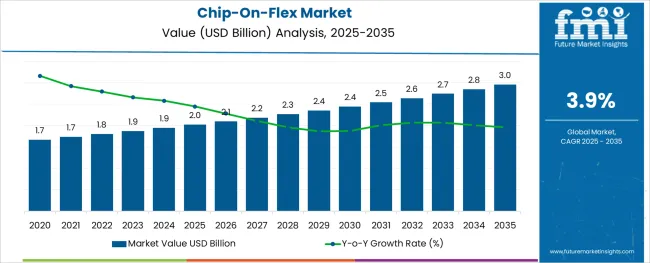
The chip-on-flex market is experiencing significant growth as demand rises for flexible electronics in various industries. Flexible circuit technology allows for compact lightweight device design, which is crucial in modern electronic applications. The electronics industry is increasingly adopting flexible substrates to enable smaller, more efficient, and durable products.
The growth of wearables, mobile devices, and IoT products has expanded the need for advanced flexible circuits. Innovations in material science and manufacturing processes have improved the reliability and functionality of chip-on-flex solutions.
Additionally, increasing investments in consumer electronics and automotive electronics have fueled market expansion. Looking ahead, advancements in flexible chip integration and cost-effective production methods are expected to drive sustained growth. Segmental demand is led by single-sided chip-on-flex technology and the electronics vertical, which dominate due to their wide applicability and technological maturity.
The market is segmented by Type and Verticals and region. By Type, the market is divided into Single to sided COD and Others. In terms of Verticals, the market is classified into Electronics, Military, Medical, Aerospace, and Others. Regionally, the market is classified into North America, Latin America, Western Europe, Eastern Europe, Balkan & Baltic Countries, Russia & Belarus, Central Asia, East Asia, South Asia & Pacific, and the Middle East & Africa.
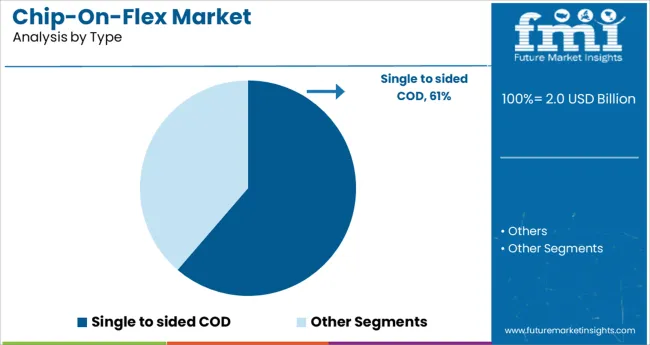
The single-sided chip-on-flex segment is projected to hold 61.3% of the market revenue in 2025, maintaining its dominance among type categories. This segment’s growth is attributed to the simpler design and cost-effectiveness of single-sided flexible circuits. Their ease of manufacturing and reliable performance in applications requiring moderate complexity have made them a preferred choice.
The segment is widely used in devices that do not require multilayer routing, making production more efficient and less expensive. Additionally, their compatibility with a range of substrates and packaging options has expanded their usability across various electronic devices.
As industries continue to demand lightweight and flexible components, single-sided chip-on-flex is expected to retain its leading market position.
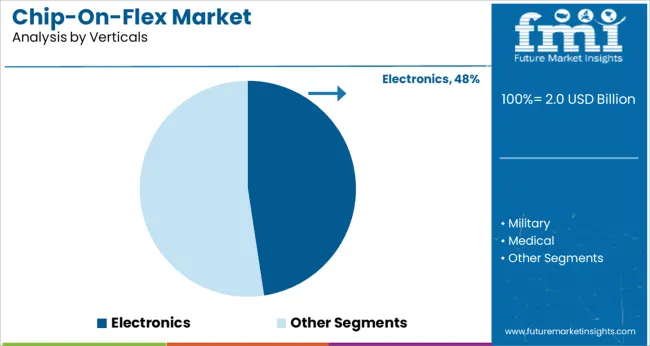
The electronics vertical is anticipated to account for 47.6% of the chip-on-flex market revenue in 2025, establishing itself as the dominant application area. Growth in this segment is fueled by the proliferation of consumer electronics such as smartphones, tablets, wearables, and other portable devices that require flexible circuitry for compact form factors.
The industry’s push for device miniaturization and enhanced durability has encouraged the integration of chip-on-flex technology. Furthermore, advancements in display technologies and sensor integration have created new opportunities within electronics for flexible circuits.
The widespread adoption of IoT devices and smart gadgets further supports growth in this vertical. With continuous innovation and expanding application scopes, the electronics segment is expected to remain the primary driver of market growth.
The increasing use of these chips in industries ensures increased accuracy with reduced cost and amplified product quality with testing repeatability. Rising demand for chips in devices such as displays, sensors, lighting, biomedical implants, and radio frequency identification which require automated manufacture with highly accurate performance is anticipated to result in exponential growth of the market.
Increasing demand for consumer electronics such as LCD, laptops, smartphones, etc., and growing ranges of applications in which the use of flex circuits also provide opportunities for the growth of the chip-on-flex market. Also, increasing investment in R&D activities and increasing product development are providing growth opportunities to the market.
Although the chip-on-flex market has numerous end-uses, there are numerous obstacles that likely pose a challenge to market growth. The increasing cost of raw materials and changing consumer needs are some of the factors that can restrain the growth of the global Chip-on-flex market. The cost and complexities related to the development of the product will hinder the growth of the market in the forecasting period.
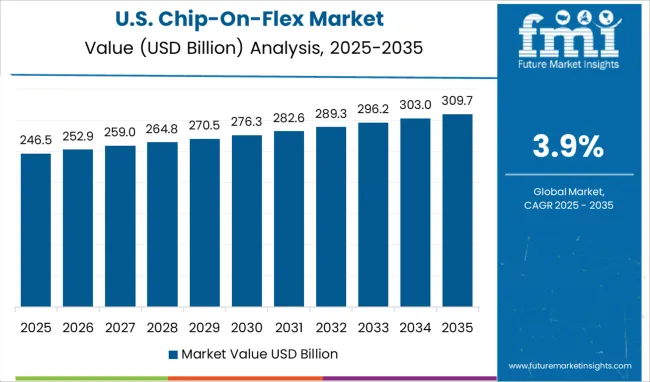
North America was the largest market for the chip-on-flex market and the trend is expected to continue into the forecast period owing to the increasing adoption of new technology specifically in the automobile sector. The region is forecast to account for 32.2% share in 2025. The growth of the chip-on-flex market is attributed to the presence of leading Chip-On-Flex manufacturers and the prominent growth of the application industries in these regions.

According to Future Market Insights, Europe is expected to provide immense growth opportunities for the chip-on-flex market, due to the presence of a large number of firms. Europe’s chip-on-flex market accounts for 21.1% share of the total global chip-on-flex market. High requirements in many end-user industries also boost the growth of the market.
Flex Logix, Digant Technologies Private Limited, and SIVA Inotec Ltd., are some of the startup companies operating in the chip-on-flex market.
In May 2025 - Silicon Catalyst, announces that Flex Logix® has joined as the newest member of its In-Kind Partner program (IKP). Portfolio companies in the Silicon Catalyst Incubator will have access to Flex Logix’s innovative embedded FPGA (eFPGA) IP and software, enabling silicon reconfigurability for use in their chip designs.
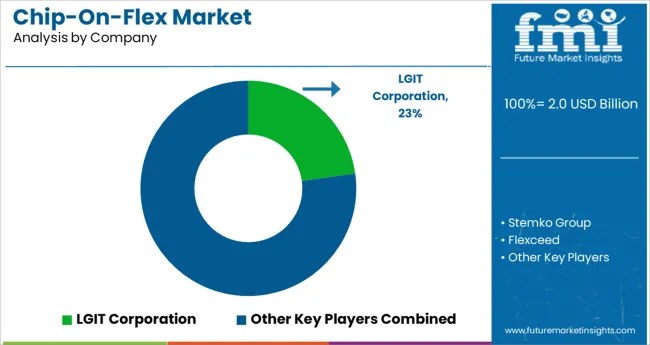
Some of the key participants present in the global chip-on-flex market include LGIT corporation, Stemko group, Flexceed, Chipbond technology corporation, CWE, Danbond technology co. ltd., AKM industrial company ltd., compass technology company limited, Compunetics and Stars microelectronics public company ltd. among others.
Attributed to the presence of such a high number of participants, the market is highly competitive. While global players such as LGIT corporation, Stemko group, Flexceed, and Chipbond technology corporation account for considerable market size, several regional level players are also operating across key growth regions, particularly in the Asia Pacific.
| Report Attribute | Details |
|---|---|
| Growth Rate | CAGR of 3.9% from 2025 to 2035 |
| Expected Market Value (2025) | USD 2.0 billion |
| Anticipated Forecast Value (2035) | USD 3.0 billion |
| Base Year for Estimation | 2024 |
| Historical Data | 2020 to 2024 |
| Forecast Period | 2025 to 2035 |
| Quantitative Units | Revenue in million and CAGR from 2025-2035 |
| Report Coverage | Revenue Forecast, Volume Forecast, Company Ranking, Competitive Landscape, Growth Factors, Trends and Pricing Analysis |
| Segments Covered | Type, Verticals, Region |
| Regions Covered | North America; Latin America; Europe; Asia Pacific; Middle East & Africa |
| Key Countries Profiled | USA, Canada, Mexico, Brazil, Germany, Italy, UK, Spain, France, China, Japan, South Korea, Malaysia, Singapore, Australia, New Zealand, GCC, S. Africa, Israel |
| Key Companies Profiled | LGIT Corporation; Stemko Group; Flexceed; Chipbond Technology Corporation; CWE; Danbond Technology Co. Ltd.; AKM Industrial Company Ltd.; Compass Technology Company Limited; Compunetics; STARS Microelectronics Public Company Ltd. |
| Customization | Available Upon Request |
The global chip-on-flex market is estimated to be valued at USD 2.0 billion in 2025.
It is projected to reach USD 3.0 billion by 2035.
The market is expected to grow at a 3.9% CAGR between 2025 and 2035.
The key product types are single to sided cod and others.
electronics segment is expected to dominate with a 47.6% industry share in 2025.






Full Research Suite comprises of:
Market outlook & trends analysis
Interviews & case studies
Strategic recommendations
Vendor profiles & capabilities analysis
5-year forecasts
8 regions and 60+ country-level data splits
Market segment data splits
12 months of continuous data updates
DELIVERED AS:
PDF EXCEL ONLINE

Thank you!
You will receive an email from our Business Development Manager. Please be sure to check your SPAM/JUNK folder too.
Chat With
MaRIA